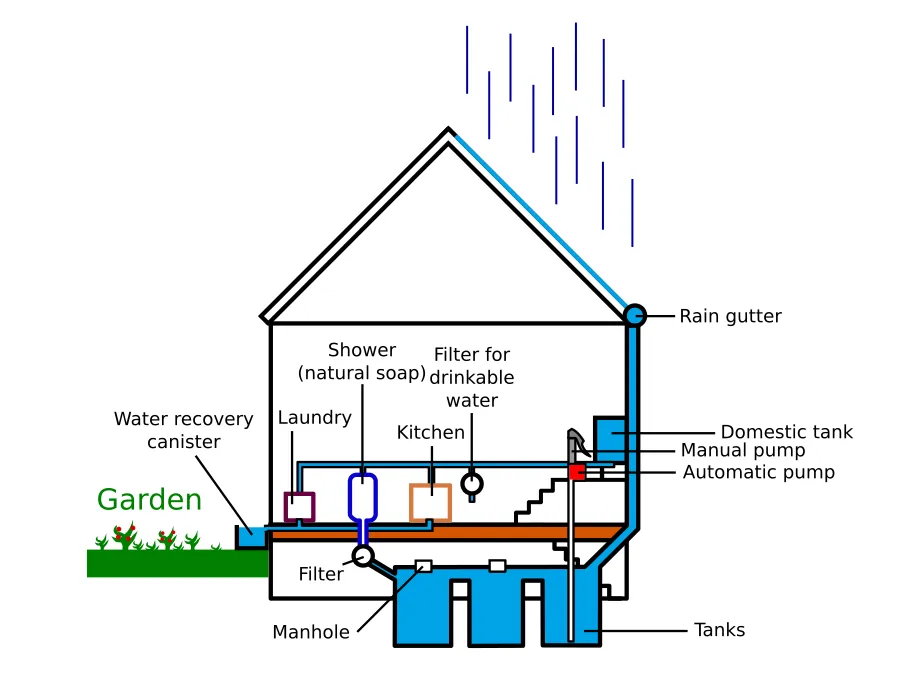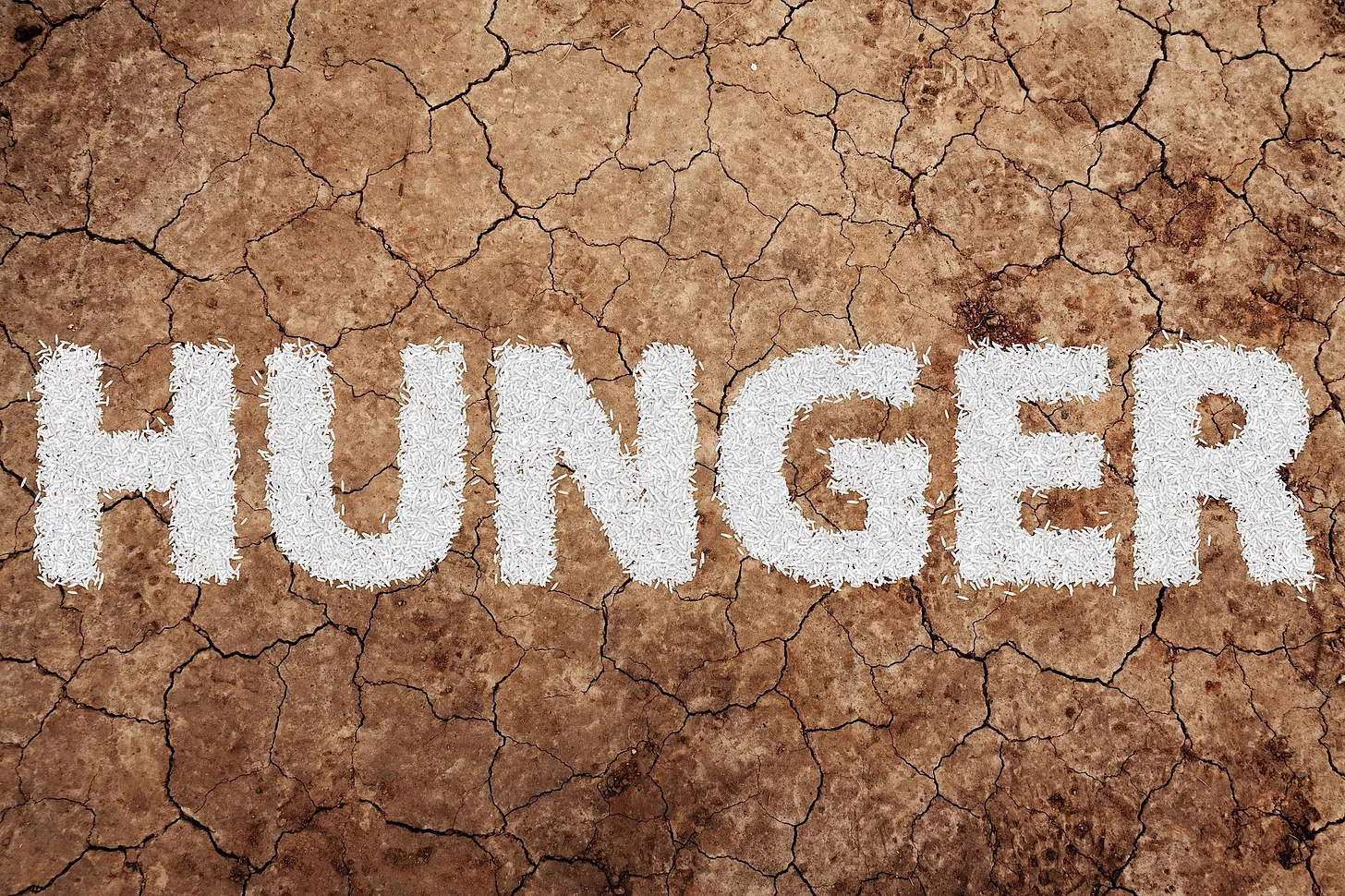How to use rain water


Abundant water everywhere
Places on Earth without water are very rare, and even when rainfall is considered low, it is still more than enough for our lives.
Let's take as a low average a precipitation of 1000 mm per year (1 m, or 3.28 feet). This is more or less what falls per year in Europe and much of North America.
If we take the horizontal surface occupied by the roofs of our houses, sheds and other garages or workshops, we only need to multiply this annual meter of water by the number of square meters of this surface to know the number of cubic meters of water running off our roofs per year.
The WHO (which is far from being the best source of health information, but that is not important here) recommends 50 liters of water per day per person to live decently (11 gallons, and 20 liters for the subsistence minimum, 4.4 gallons). This amount includes drinking, showering, washing dishes and laundry.
Knowing that a standard size house for a family of four (two parents and two children) is at least 100 square meters on average, this means that about 100,000 liters of rainwater (about 22,000 gallons) per year flows over our roofs, or 68.5 liters per person per day (about 15 gallons).
This is enough for our own use, and it only takes into account the roof of the dwelling, the annex roofs are not included in the calculation.
In fact, if we take again the WHO recommendation, and with the same approximations of yearly rainfall, we need 18,25 square meters per person of roof to collect enough rain water for everyday life. It means around 54800 persons per square kilometer (142000 per square mile). So it could work quite well for cities without too much air pollution.
Drinkable water everywhere
Let's see now if this rainwater as such is interesting. Is it first of all drinkable?
Yes, absolutely! The places where rainwater is not drinkable are big agglomerations and places where there are polluting industries.
The rest of the rain will be potable and even quite good. Indeed, the low mineralization of the rain gives it a neutral taste that many people appreciate. But it can be even better with the right process… we will see how further.
A study conducted by an independent researcher in France (as many others around the wolrd) easily showed that rainwater is of better quality than tap water, which is treated with chemicals and transported over long distances in plastic pipes.
This researcher himself installed his own rainwater harvesting tank at home.
Finally, for those who want to ensure a healthy drinking water, it is also possible to use a gravity water filter or a water distiller. Everyone can make their own choice because the different brands on the market have their pros and cons. Berkey is quite well known and recognized, but the problem remains that its design is kept secret and that it is therefore impossible to truly evaluate its action on water other than through classic and expected analyses.
By using this type of solution, you can afford to consume water that was originally not very pure (on the other hand, it is not advised for filtering heavy polluted water).
It is also recommended to pre-filter rainwater before it reaches the storage tanks. Several solutions exist, most of them based on ceramic and carbon. The maintenance of these filters is minimal: cleaning in case of clogging and replacement of materials at most once a year.
This pre-filtration will prevent coarse elements such as dust or pollen from being deposited in the tanks. If carbon is present, some hydrocarbons and pesticides can also be removed.
Store water anywhere
While rainwater is globally very available and in very good quality, many regions have occasional rainfall and long periods of drought. This in itself justifies the storage of harvested rainwater for small-scale daily use.
There are different elements to consider:
evaporation
temperature
stagnation
The tendency of water to evaporate, especially in dry and hot regions, implies a rather closed storage (not hermetic to air though), sheltered from wind and heat.
Moreover, a high temperature can have a negative impact on the water by favoring the development of potentially pathogenic microorganisms. It is therefore necessary to provide a cool place to store water.
Finally, stagnation is the most delicate element. Stagnant water can also lead to an excess of undesirable microorganisms.
The two surest ways to drastically limit the phenomenon of water stagnation are to pump water weekly into our cisterns for our uses (with an outlet at the bottom of the cistern of course) and to have several cisterns.
Indeed, it is necessary from time to time (we often speak of every 15 years) to clean out our cisterns (empty them completely, clean them and check their water tightness). It is therefore important to have at least two tanks.
If the connection of the tanks to each other is too difficult, at least one water inlet per tank should be provided.
Finally, the material used for the cisterns should if possible be direct rock or masonry covered with a mortar of natural materials like lime and clay.
If this is not possible, concrete remains the least bad (avoid plastic tanks whose degradation is difficult to predict and contamination with particles rather random).
Moreover, tanks made of rock or its derivatives (including concrete, to a certain extent), will contribute to a balanced remineralization of the water (generally below 100 mg/L, which is ideal for drinking water) and of the pH (acid in the case of rainwater, it becomes neutral when in prolonged contact with the rock).
Ideally, these tanks will be installed underground to keep a fresh and stable temperature all year long.
Let it flow… or pump it up!
First, let's talk a little about get the water from our tanks before talking about its use.
One detail is very important in a synergetic approach: it is always to minimize the risks of malfunction and the consequences of the latter if it happens.
Two cases are possible depending on your house:
- rely on gravity alone
- installing pumps when the tanks are in the basement, or even underground
The first solution is possible for houses built on slopes or with fresh storage on the floors (which is very rare).
In the case of houses on a slope, the proximity of the ground or even the rock guarantees a certain freshness to the water in storage. Avoid at all costs storing water in a place where it is hot and where there are temperature differences depending on the time of the year. This encourages microbial growth and can make the water unfit for consumption.
In the case of houses on flat or slightly sloping ground, and needing to use underground tanks (which is the most frequent case), it is highly advisable to equip ourselves with manual pumps that can be upgraded with an automatic system, so that if the latter fails, we are still able to pump water manually, which is essential given the importance of water for our survival and our lives.
If this is not possible for technical reasons, then two pumps should be used, one assisted (preferably electric to avoid gas escapes in a confined environment and reduce the noise of the pump) and the other manual, in case of failure of the first one.
Of course, those pumps have to be as repairable, modifiable and expendable as possible.
They also must be easily connected to each of the tanks with compatible hoses (connectable with each other), and if possible flexible enough for maneuvering more easily.
And finally, let’s not forget to add convenient manholes to each top of the tanks to check their condition, fill level and go down into it for maintenance.
Use and reuse water
When our installation is ready, it's time to use it. It is very important, as much in a synergetic as in an ecological or survival context, to optimize the use of water as much as possible (without it becoming a headache if possible).
For example, shower and dish water can be used to water the garden. If you take your shower without soap (which is my case for years without any problem), the shower water can be easily potabilized and consumed or even reinjected in our tanks. It can also be reused for the dishes or the laundry and then for the garden (some household products are very well assimilated by the soil and the plants without any risk of pollution).
By the way, showering with water that is low in minerals is better for your health and your skin.
If our toilets work with water, it is possible to install a lagoon at home, as long as we have enough outside surface available (I will come back to the principle of lagooning in a future article).
Otherwise, dry toilets will be a good way to reduce our water use.
In the same way, it is possible to adapt this system to livestock, vegetable gardens and orchards. Sometimes this will not require an underground tank and simple collection bins will suffice. Let's not forget that greenhouses, workshops and stables constitute large surfaces of rain runoff that are almost never optimized.
The fact is (and, here again, I will come back to this in a more developed article on the topic) that what makes the use of an element really optimized is not so much its stock as its flow.
The best-known example is certainly the banknote, which circulates from hand to hand until it creates a mini-economy without being duplicated. Simply, it is its movement (its flow) that has allowed and generated exchanges and therefore rendered services to the community.
It's the same with everything and it's the same with water.
In conclusion
Water is abundant and available in most places on Earth, and it is safe and almost immediately potable.
Current building designs have completely lost this essential relationship with water, and it is usually private initiatives that make the difference in this area.
Two things are therefore very relevant regarding the promotion of a synergetic design:
to include rainwater harvesting systems again in the construction plans of houses and buildings
to share these plans and the ideas that go with them so that as many people as possible can benefit from them
Where I live, there is three underground tanks made of rock and mortar. They are quite old but they gather the rain water really well and keep it fresh all year long as expected. Some repairs are planned and we began recently a project to divert water from the showers, the sinks and the laundry machines toward additional cans to water the garden.
So, here is my contribution:

Toilets were not represented on the picture because management of wasted water from toilets is very different than the other wasted waters and will be the subject of a future article on the lagoon solution.



